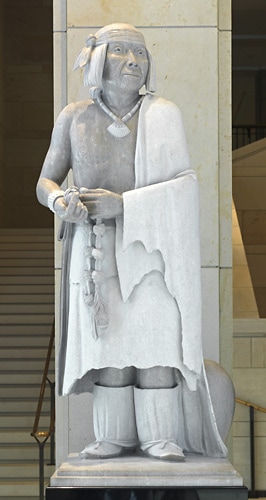 By The Architect of the Capitol (http://www.aoc.gov/cc/art/nsh/popay.cfm) [Public domain], via Wikimedia Commons
By The Architect of the Capitol (http://www.aoc.gov/cc/art/nsh/popay.cfm) [Public domain], via Wikimedia Commons When you think of American Revolutions, do you think of Americans fighting a foreign overlord in order to avoid excessive taxes, worship and live as they please, and follow their own form of government?
Do you think of Paul Revere, George Washington, and Nathaniel Hale?
Does 1776 come to mind?
Although the first American Revolution was about taxation and freedom of religion, it wasn't fought by colonists in the 13 colonies that hugged the eastern seaboard, and it wasn't a battle with England. America's first freedom fighters were Puebloan Indians, who rose up against their Spanish overlords in 1680. Their leader was a man named Popé.
The Spanish Empire expanded into the New World soon after Christopher Columbus "discovered" it in 1492. By 1540, they began exploring what is now Arizona and New Mexico. By the time Juan de Onate settled, in 1598, the Spanish had imposed themselves on over 100 Indian settlements, which they called pueblos because they reminded the Spaniards of villages back in Spain. The Puebloans were not a single people. Although they were all settled rather than nomadic, they spoke a number of different languages and had different religions and cultures.
From the very beginning, the actions of the Spanish towards the Puebloans were harsh and repressive. Oñate put down resistance from the Acoma pueblo by chopping a foot off every man over fifteen and enslaving the rest of the population. Priests set up missions next to pueblos, forcing the people to build churches and punishing them if they practiced their own ancient religions. Soldiers imposed the encomienda system, a forced-labor system similar to the serfdom of medieval Europe.
In the 1670s, a drought swept through the region, causing famine and increased raids by the Apaches, which Spanish and Pueblo soldiers were unable to prevent. Spanish and Indian alike were reduced to eating leather cart straps. Desperate for rain, the Puebloans turned to their gods, causing the Governor to arrest 47 Puebloan leaders on charges of witchcraft in 1675. Four medicine men were sentenced to death by hanging. The remaining men were publicly whipped and sentenced to prison. One of those men was Popé, a medicine man from Ohkey Owingeh (which the Spanish had renamed San Juan).
After eighty years, the Indians had had enough. Despite their different languages, the Puebloan leaders coordinated their attack to begin everywhere at once. Runners carried knotted ropes like the one in the statue's hand to mark the days until the revolt was to occur. When two of those runners were captured and tortured into revealing the date of the uprising, its leaders decided to start it early.
On August 10,1680, the Puebloans attacked. By August 13, all the Spanish settlements in New Mexico had been destroyed. 21 Franciscan friars and more than 400 Spaniards had died, but over a thousand survivors managed to make it to safety in the governor's palace in Sante Fe, and later escaped to El Paso, Texas, where they would bide their time until they could retake New Mexico twelve years later.
The Spanish were never able to eradicate Puebloan culture and religion. After the reconquest, they issued land grants to each Pueblo and appointed public defenders to protect the rights of the Indians and argue their legal cases in the Spanish courts. The Franciscan priests stopped trying to impose a theocracy on the Puebloans, who were now allowed to practice their traditional religion
Popé's statue stands in the Capitol Building in Washington DC. He was able to unite a disparate group of peoples and lead the most successful Indian uprising in the history of the West. The success of the Pueblo Revolt could be one reason why the Pueblo peoples continue to remain in their ancient ancestral homes instead of in distant reservations, why they are self governing, and can freely practice their religion.
Like primary sources? Click here for a transcript of a letter, dated September 8, 1680, in which the governor and captain-general of New Mexico, Don Antonio de Otermin, gives an account of what happened to him during the uprising.
The author of several novels, Jennifer Bohnhoff teaches New Mexico History to 7th graders in Albuquerque, New Mexico.

